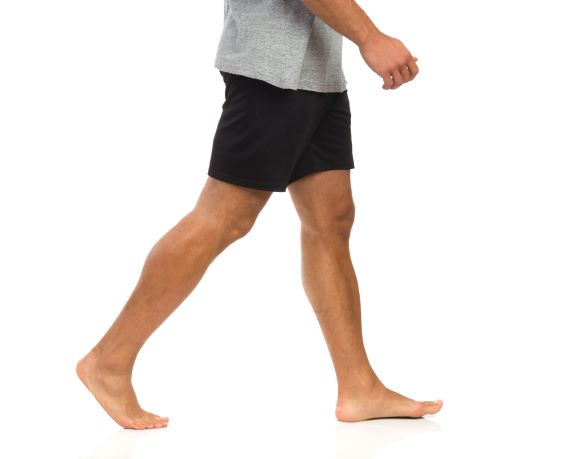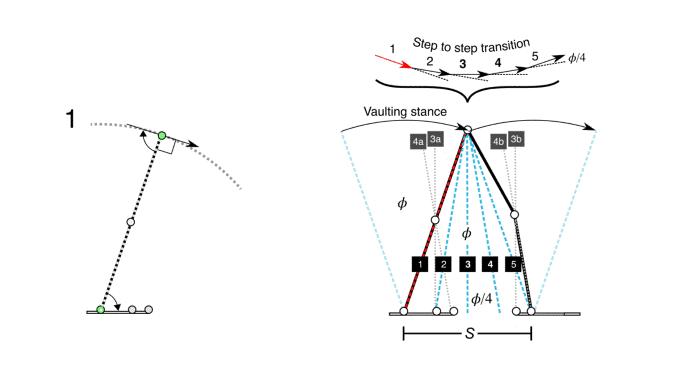New RVC research explains human foot and leg proportions
Novel research from the Royal Veterinary College (RVC) examining the human walk has been able to predict leg and foot proportions using collisional geometry. The findings suggest why modern humans have a knee halfway down their legs, short heel and toes, a stiff, longer midfoot, and why a comfortable step is two to three feet long.

Human legs and feet have evolved over time. Since our common ancestor with the great apes, human leg length has increased, the leg in stance has become straighter, feet have become stiffer and toes shorter. Whilst this evolution has resulted in legs capable of climbing, swimming and running, it is likely that human legs have adapted mainly for economical walking. However, although there has been a significant number of studies on this evolution of the structure and function of human legs and feet, the mechanical implications and the benefits of human leg and foot proportions have not previously been demonstrated.
Jim Usherwood, Professor of Locomotor Biomechanics at the RVC, set out to interpret the basic aspects of leg and foot function and geometry in the context of economical bipedal walking, and subsequently discovered a surprisingly simple reason for their configuration. His findings also shed light on how the complex and rapid sequencing of muscle actions is controlled.
Usherwood used collisional geometry – a method to model fundamental mechanics familiar to anyone who has played pool or snooker – to determine how bipedal walking would be achieved most economically. By briefly ‘locking’ the various joints of the leg and foot in rapid succession with different muscles ‘taking up the slack,’ humans manage a smooth step-to-step transition. This may simplify control as each muscle can simply react to being pulled through changing geometry, rather than require a large number of perfectly timed signals from the brain.
The study found that the geometry of the smoothest – and so most economical – transition goes a long way to explaining features of the evolved human leg and foot. The geometry is clear from pencil-and-paper sketches and, in contrast with most modern approaches, requires absolutely no computer modelling. It returns to concepts from 30 years ago inspired by passive walking toys, but that did not recognise the importance of the flexing knee and double-foot-support in smoothing the step-to-step transition.
The new theory predicts that the knee joint is best if it is positioned halfway down the leg, the heel should be a quarter foot length, the stiff midfoot should be a half foot length and the toes a quarter foot length; and that step lengths should be two to three feet long. These predicted proportions match modern human legs and walking style remarkably closely.
Jim Usherwood, Professor of Locomotor Biomechanics at the RVC, said:
“Whilst the idea requires many assumptions and leaves out a great deal of detail about actual human legs, it is really pleasing that some simple geometry and fundamental mechanics begin to explain why human legs are the way they are, and walk the way they do.”

Notes to Editors
Reference
Usherwood JR. 2023 The collisional geometry of economical walking predicts human leg and foot segment proportions. J. R. Soc. Interface 20220800. https://doi.org/10.1098/rsif.2022.0800
The full paper is available here: https://doi.org/10.1098/rsif.2022.0800
For media enquiries, please contact:
- Jasmin De Vivo (jasmin.devivo@plmr.co.uk) or rvc@plmr.co.uk
- Press Line: 0800 368 9520
About the RVC
- The Royal Veterinary College (RVC) is the UK's largest and longest established independent veterinary school and is a Member Institution of the University of London.
- It is one of the few veterinary schools in the world that hold accreditations from the RCVS in the UK (with reciprocal recognition from the AVBC for Australasia, the VCI for Ireland and the SAVC for South Africa), the EAEVE in the EU, and the AVMA in the USA and Canada.
- The RVC is ranked as the top veterinary school in the world in the QS World University Rankings by subject, 2022.
- The RVC offers undergraduate and postgraduate programmes in veterinary medicine, veterinary nursing and biological sciences.
- The RVC is a research led institution with 88% of its research rated as internationally excellent or world class in the Research Excellence Framework 2021.
- The RVC provides animal owners and the veterinary profession with access to expert veterinary care and advice through its teaching hospitals and first opinion practices in London and Hertfordshire.
You may also be interested in:
-
How changing limb posture helped ancient reptiles grow
New collaborative research from the Royal Veterinary College (RVC), along with the Institute of …

